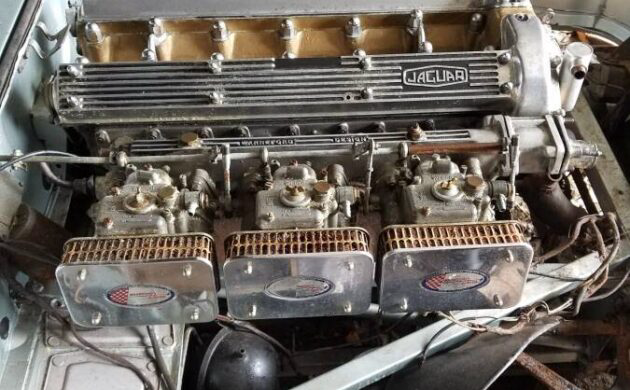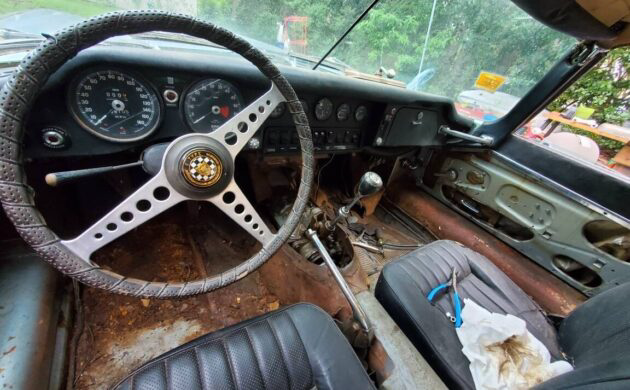Project 1970 Jaguar XKE Convertible with Hardtop
Hearts beat faster when a Jaguar XKE is nearby. One of the most glamorous cars ever conceived, the XKE was based on the D -type race car and designed using a wind tunnel. Despite its good looks, it was also built to sell at a reasonable price – a fact that was appreciated at the sales counter but did it no favors longer term. Owners who could afford to buy the machine often could not contend with the hefty maintenance bills. Speaking of hefty bills, those are in store for the new owner of this 1970 Jaguar XKE convertible project, for sale here on craigslist, asking $42,000. This car is located in Jacksonville, Florida. Thanks to Patrick S. for the tip! The Opalescent Blue panels look decent but the factory didn’t provide rustproofing so further investigation is essential. The bonnet gap meeting the sill is wide but the bonnet may simply not be fully latched. Better hope so, because the bonnet is made of fifteen separate panels and is notoriously difficult to fit. This car sports wire wheels and a rare hardtop, with a leather headliner.
This car is a Series II, with a DOHC 4.2-liter inline six-cylinder motor paired with a four-speed manual transmission. The 4.2 engine generated an astounding 265 bhp when equipped with triple SU carburetors, with a top speed of 150 mph. It was very quick off the line, too, traveling 0 to 60 in seven seconds. The owner indicates this is a matching numbers car, and it comes with a British Heritage certificate. This car is equipped with a racing manifold and triple Webers. Webers don’t like our low-grade American gas, they don’t like hot weather, they don’t like cold weather, it’s hard to find people who know how to jet and tune one let alone three, so now you know how I feel about Webers. I would revert immediately to the SUs this Jag was meant to run with.
In the cockpit, the dark blue leather seats are in decent condition and the dash looks complete, but that’s where it ends. This car has rusty floors. Replacing those is not for the faint of heart. The rust appears up the side of the tunnel and may be in the sills and inner structures as well.
The bumpers, windshield, and lights look to be in good shape. This photo shows the top bows and a top. The owner tells us that the car rolls and steers enough to be loaded on a trailer. While this example has promising aspects, do not underestimate the expense of resurrecting this Jag. To the uninitiated, the complexity of these cars is a shock. Accordingly, what do you think of the price here?
Auctions Ending Soon
 2002 Subaru Impreza WRXBid Now2 days$333
2002 Subaru Impreza WRXBid Now2 days$333
 1975 Chevrolet Corvette ConvertibleBid Now3 days$3,000
1975 Chevrolet Corvette ConvertibleBid Now3 days$3,000
 1964 Ford F-100 Camper CustomBid Now3 days$2,000
1964 Ford F-100 Camper CustomBid Now3 days$2,000
 2006 Jeep Wrangler SportBid Now4 days$10,500
2006 Jeep Wrangler SportBid Now4 days$10,500
 1974 Datsun 260ZBid Now6 days$200
1974 Datsun 260ZBid Now6 days$200





Comments
In 1970 the series 2 E-Type had two Zenith carbs in the US, rather than the triple SUs of the series 1. The engine produced 240hp, top speed was 130mph, and 0-60 was 7.5 seconds.
Dang! Thanks for the correction, I don’t like Zeniths – must have just blocked that.
Sisuman: a ’68, ’69 and early ’70 American specification car with the twin Zenith-Strombergs and EGR from the rear exhaust manifold only, did 138 mph. The latter 1970 and ’71 with EGR from both manifolds, with reduced compression, wider valve gaps, ash cannister, and reduced gearing, could barely make its way to 125 mph. Wherever you got your 130 mph number from must have been sort-of averaging both variants.
The uniquely Canadian variant from ’69 up to May of 1970, put out 255 bhp, with the twin Zenith-Strombergs but no EGR. They had the same top speed and acceleration as a Series I, because the small 10 horsepower reduction at the crank, was compensated for with way less back-pressure in the exhaust, as the twin Zenith-Strombergs and the more powerful distributor, created a much better burn. This is why the also thermostatic Zenith-Strombergs replaced the simple but dirty triple HD-8 SUs (the SU had been patented in 1922…a full century ago). To not forget the home market Series II, as well as Series II cars sold in Europe, Australia, etc, they all had the three SUs and no anti-pollution, continuing to put out the full power of a Series I, except with improved revving speed in the upper rpm band, thanks to reprofiled cams (a point hardly ever mentioned anywhere).
The twin Zenith-Strombergs have often been maligned, but they did the job of the three SUs, while reducing emissions and giving an improvement in mileage. What actually brought power down were all the other things mentioned above that Ralph Nader and the anti-performance bureaucrats liked.
Laurence, well-written and very informative. Thank you!
LS…. No, I just can’t say it. Beautiful machine, even as is, but everyone knows that.
If you like a project and like to work for free… this is your ticket. If you want a car like this… the cheaper route is to spend much, much more money up front and buy it fully sorted.
As for fitting the bonnet I can assure you that is at minimum a 4 man job as I have done that more than once and it is a total pain in the ass to get right but like so much about a XKE when done right it is worth it. Given the proximity to salt water a serious inspection is critical as you are right about the rust protection and that mixed with not the greatest paint can cause serious damage.
If you are of a mechanical bent these are cars that if you have an equipped shop and some trusty friends with talent you can restore yourself but TAKE YOUR TIME AND GET IT RIGHT. First thing is make certain that the starter is good because there is no way to remove it with the engine in place. One of the biggest blunders of the design.
As for the worth I have seen perfect examples go for the wide side of $150,000 and more. Well worth the effort. If money is not that important get a Tonneau Cover for driving this car in a cool fall day with the passenger side covered up, the side windows up is an amazing experience. I have only done it a very few times in an XKE like this or in my friends V-12 and both are memorable. But then I live in an area where the colors of the trees in the fall is beautiful.
I wish I was not involved with a couple of Lotus right now or this would be mine upon inspection.
Not true! You can indeed remove the starter with the engine in place. There is an access hole for the otherwise impossible-to-get-to upper starter mounting bolt in the transmission tunnel. Simply peel back the carpet and insulation on the right side, remove the rubber plug, and insert your 12″ ratchet extension. Bodda boom, bodda bing, your starter is on the garage floor in no time!
Bruce: thank you for your heart-felt comments, most of which are correct. However, I think you have confused the starter motor with the clutch. To do a clutch job the engine has to be removed, along with the bonnet, which is indeed a bloody nuissance. The starter motor, though, comes out relatively easily when you put the car up on a hoist. As a matter of fact I needed to check my E Type’s starter very recently as it was making a slight noise I didn’t like, and it took me less than an hour to remove, with hand tools. Fortunately all that was needed was to tighten the bolts, as they had loosened with time and creayed a slight misalignment causing the whine.
i got to dis agree Bruce , i dropped many starters from 3.8 4.2 e types , with no problem just got to be taught by one of the BEST thanks JJ
That won’t last long!
Do you mean it will sell quickly or completely decompose into a pile of rust?
looks fool so many people with e types and take it from me i bought quite a few in my life from series 1 3.8 to series 3 v12 and boy does these get to be a money pit if you buy the wrong car,and this 150mph crap never happened on any but the first car tuned at the the factory,the yank ones could hardly pull your foreskin back especially the 4.2 stromberg cars 2+2 automatics,but like i say the cars look beautiful but to live with one on a daily basis is not for the faint hearted,give me a Jensen interceptor convertible or a sunbeam tiger any day and the 289 tiger will trounce any e type and the service parts are cheap as chips they are just not as pretty and so are the 440 jensen parts
I daily drove an E Type in my late 20’s. Granted it would have been only 10+ years old then and fresh out of a thorough rebuild, but with attention it proved reliable and I wasn’t afraid to take it out of town. Happiest running at Interstate speeds.
I don’t understand the Weber comments. Properly synched and jetted they worked just fine on a different car, an Opel 1900 I street drove and autocrossed.
i have to dis agree with the comment about removing the clutch , unless one really knows the in and outs on these e types , to much explaining to do, but it is true one can remove the clutch with out pulling the motor & gear box , i know this will start a buzz going but i already done it several times thanks jj
Robert: to the best of my knowledge, if you need a new clutch for your six cylinder E Type it is an engine and gearbox-out job. The only way, as far as I know, to leave the motor in and make it a transmission-out-only job, is to severely hacksaw the gearbox housing…an absolute no-no when dealing with a car that commands six figures in nice shape. It is worth paying the twenty hours of labour that a competent Jaguar shop will charge to avert such desecration that will bring down the value far more than that cost. However, if you know of some other way of not removing the engine that allows for a tidy and non-destructive clutch replacement on an XK-powered E Type, myself and plenty of others would be thrilled to know what to do.